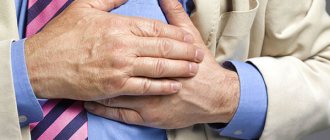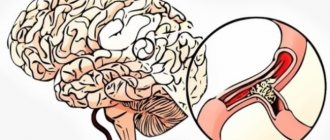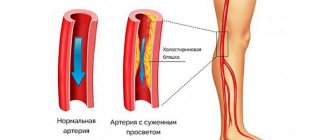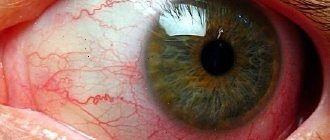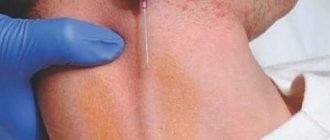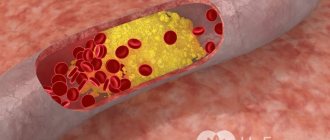Headaches and dizziness are often associated with changes occurring in the blood vessels of the brain. They can be triggered by a disease such as atherosclerosis, which is affecting more and more people.
Currently, this disease does not spare even young people, although people over fifty are much more susceptible to it. Narrowing of the blood vessels in the brain often occurs in children.
Risk factors and pathophysiology
Symptoms of vasoconstriction are often expressed in the form of difficulties with remembering information, sudden mood changes for no particular reason, and unsteady gait. To understand how to treat disease-prone arteries, you need to become familiar with the factors underlying the pathology.
Atherosclerosis occurs due to the fact that cholesterol plaques accumulate on the inner surface of the brain (and not only) arteries, resulting in a narrowing of the blood vessels in the head. Blood flows more slowly through narrow arteries and veins.
When the vessels of the head and neck are narrowed, the brain begins to experience more and more severe oxygen starvation, which is accompanied by a disruption of many of its functions. Moreover, the resulting plaques can completely clog the passages in the arteries. This is a very dangerous phenomenon that leads to a variety of health problems.
What are the most typical causes of cerebral vasoconstriction?
Why are blood vessels narrowed, what means cause them to expand? Typically, deposits on the vascular walls appear as follows:
- Fat-rich foods lead to increased cholesterol levels.
- The blood vessels in the head become less flexible.
- Indelible plaques appear in the arteries, to which platelets contained in the human blood adhere, as a result of which the patency of the artery decreases and its lumen narrows. As a result, stenosis of cerebral vessels develops.
The initial characteristic symptoms that appear when the arteries and veins narrow are very mild and almost unnoticeable, so many people ignore such symptoms, which is extremely dangerous.
Over time, the symptoms of vasoconstriction manifest themselves more and more clearly, causing a person more and more inconvenience and discomfort.
Later signs of cerebral vasoconstriction can be expressed by coordination changes, paralysis and other pathological conditions of the body.
What can lead to pathology:
- Hypertension. As a result of systematic changes in pressure, the elasticity of a person’s veins decreases.
- Atherosclerosis. In this case, the arteries narrow as a result of the appearance of dense cholesterol plaques inside them.
- Osteochondrosis. In this case, the reason for the change in cerebral circulation lies in those destructive changes that occur with age in the intervertebral cartilage.
All these pathologies are included in the group of cerebrovascular diseases.
Symptoms of weak heart vessels
Lack of activity of the arteries and veins of the heart has a detrimental effect on the functioning of the myocardial muscle fibers. The negative impact on the efficiency of the atrium and ventricles limits the function of pumping blood, and stenosis develops throughout the body.
The main symptoms indicating instability of blood flow are motion sickness when traveling on any transport, increased dizziness, shortness of breath, shortness of breath.
With further development of vascular canal pathology, the following appear:
- Jumps in blood flow pressure - hypersympathicotomy;
- Hypertensive headache;
- Pale skin is a sign of a disease with impaired blood circulation;
- Weakness, constant fatigue and drowsiness indicate spasms of the walls;
- The appearance of swelling of the limbs by the end of the day - weak tone;
- Disturbance of myocardial rhythm after a heavy meal, little physical exercise, or in stressful situations. The feeling of the heart “jumping out of the chest” is typical;
- Chronic cough is a lack of blood supply to the lung tissue.
An increase in the symptomatic picture leads to the development of myocardial infarction.
Symptoms of the disease
Symptoms of cerebral vasoconstriction in the vast majority of cases are characterized by a gradual onset, but sometimes occur suddenly. The consequences in such a case can be the most dire. Due to a sharply narrowed passage in the artery, a person may experience a stroke, which can lead to loss of mobility and even death. Chronic stenosis of the head and neck vessels develops over several years; its first signs are invisible.
In the chronic form of the disease, there are 3 stages:
- I have a slight headache, I want to sleep even during the daytime, and sudden mood swings occur.
- Severe and frequent headaches, unsteady gait, malfunctions of the urinary system, causeless mood swings, and a significant decrease in performance appear.
- Often there is loss of balance when walking, involuntary urination, constant forgetfulness, and dementia.
Often people do not start treatment for the blood vessels of the head on time. They do not pay attention to the symptoms that arise and ignore the signs of the disease until the beginning of its third stage. To eliminate symptoms, they use pills and other potent medications. This should not be done, since the consequences in this case can be very serious.
When the first signs of this pathology appear, it is necessary to urgently begin treatment of cerebral vessels using traditional methods or with the help of medications. To cope with this disease, you need to be well aware of its main symptoms and treatment.
First stage
The disease begins with minor disturbances, the symptoms of which in many cases are perceived as overwork, the influence of magnetic storms or bad weather. Over time, the body adapts to all pathological manifestations and ceases to respond adequately.
During this period, short-term memory decreases, emotional stability is lost, and periodic headaches appear. If the resulting disorder is not treated, the disease gradually progresses to the next stage.
What can the development of such a pathology lead to?
Narrowed cerebral vessels can lead to rupture of aneurysms.
Pathology of cerebral vessels can develop at a young age, even in a child, but most often it occurs in older people. The prognosis is most favorable for young patients. The chances of recovery also increase when the disease is diagnosed in the early stages and competent therapy is prescribed to the patient in a timely manner.
What is dangerous, what does a decrease in the lumen of veins and arteries lead to? Narrowed arteries can cause the development of the following pathologies in humans:
- decreased intelligence;
- feeling of annoying noise in the ears;
- memory problems;
- systematically recurring migraines;
- absent-mindedness, etc.
Mechanisms of pathology
Cholesterol is a substance without which the body cannot function properly. It is involved in metabolism and the construction of new tissues, and is a source of antioxidants. Cholesterol is produced by the liver, and a significant part of the substance comes from food. It is divided into low and high density lipoproteins.
The texture of high-density lipoprotein is similar to wax - it is a sticky and viscous substance that settles on the walls of the inside of blood vessels. Gradually, calcium molecules are drawn to the substance, thanks to the properties of which the formed plaque hardens.
Every day, with the influx of lipoproteins, new layers are deposited on the cholesterol plaque, increasing its size. The lumen of the vessel decreases, which leads to impaired blood circulation, thinning of the walls, loss of elasticity and mobility.
A decrease in the elasticity of the arteries leads to the appearance of microcracks, and the complication of blood flow leads to the accumulation of blood components in them. This is how a thrombus is formed - a blood clot, which, in addition to aggravating the developing disorder, poses an additional danger. If a blood clot breaks off and enters the general circulation, it can clog any blood vessels.
Features of treatment of cerebral vessels
How to treat cerebral vessels? There are several ways to expand the lumen of the arteries and narrow the lumen of the veins. Along with intensive drug therapy, folk remedies are also used to treat cerebral vasoconstriction.
Treatment options include:
- drug therapy;
- correction of the condition using surgical methods;
- correction of habits;
- diet therapy;
- use of folk experience.
What is drug treatment in this case? It consists of taking cholesterol-lowering drugs and drugs that provide vasodilation. All medications are prescribed to the patient by his attending physician.
Surgical treatment is used in the most difficult cases, when no other measures are successful. The patient may undergo carotid endarterectomy, during which the vessel is dissected and mechanically cleared of cholesterol plaques.
A more progressive method of therapy is angioplasty (pushing out cholesterol clots from an artery using a catheter inserted into it). Sometimes the patient is prescribed carotid vein bypass surgery.
Third stage
During this period, there is a serious disturbance in the patient’s coordination, he constantly loses his balance and practically cannot do without an accompanying person. In rare cases, complete failure of the musculoskeletal system is observed. The functions of the pelvic organs are disrupted, urination is completely out of control. The patient constantly forgets everything, speaks incoherently with significant distortion of words, which is assessed as a sign of dementia.
In many cases, the last stage of the disease can no longer be treated; many disorders in the structures of the brain become irreversible.
Parents of a child who has suffered vasculitis, birth trauma, or has congenital insufficiency of the circulatory system, heart or kidney disease, need to be especially careful. The most common symptoms in childhood are nausea, dizziness and headaches. You need to visit a doctor and treat vascular diseases immediately, otherwise there may be fatal consequences for the mental and physical development of the child.
Diet therapy and cessation of bad habits
Giving up bad habits - and the blood vessels in the brain will not be narrowed
Changing habits involves giving up alcohol and smoking, and switching to an active lifestyle. Try to spend more time outside, watch your weight, get good sleep and control your blood pressure, preventing it from unexpected jumps.
By giving up bad habits, a person not only gets rid of vascular problems that can lead to deterioration of health, but also improves his well-being. Try to avoid using transport as much as possible. By walking, you will speed up blood flow, thereby preventing the arteries of the cervical region from narrowing. Hardening procedures are also very useful.
Diet therapy also brings tangible benefits. You need to drink more water and increase the amount of vegetable dishes in your diet. They contain a lot of slowly digesting fiber, which has a beneficial effect on blood vessels, as well as other organs. Drink juices and fruit drinks constantly. Fatty foods clog arteries, while water, on the contrary, cleanses them, washing away all excess deposits.
After waking up, it is useful to drink some water at room temperature. The lumen in the vessels under the influence of water significantly expands, as a result of which blood circulation is normalized.
Avoid salty, fried foods, cakes with rich cream, and carbonated drinks. What else should people suffering from vascular pathologies not eat? They should not eat pickled vegetables, meat broths, or chocolate products. You should also minimize your salt intake.
All food should be cooked in vegetable oil, which contains polyunsaturated acids. It is also beneficial to eat seafood. Their regular use will help normalize the functioning of not only blood vessels, but also the thyroid gland.
Strengthening blood vessels on your own
Strengthening blood vessels consists of following the principles of a healthy lifestyle: a balanced diet, physical exercise, regular water treatments, restorative massage, and the use of folk remedies.
- The first and basic rule of a healthy lifestyle is moderation . It is very important not to overeat. You should eat food 4-5 times a day. Fractional nutrition in small portions with a limit on animal fats, fried foods and simple carbohydrates is the key to good health and longevity. Coffee, soda, salt and sugar have a negative effect on blood vessels and the body as a whole. Excessive food consumption in people with vascular problems can lead to asthenia of the body, manifested by headache, malaise, and fainting. During the day it is recommended to drink up to 2 liters of water and eat plenty of vegetables and fruits. They are a source of vitamins and minerals, as well as fiber. Experts advise eating a clove of garlic every day. A glass of boiled water with lemon juice and honey, drunk at night, will help strengthen the walls of blood vessels.
- Physical activity can increase vascular tone and strengthen them . Experts recommend visiting the gym at least 3-4 times a week for 15-20 minutes. Gradual adaptation will allow you to avoid overwork and overstrain of an already worn-out vascular system. Walking, cycling, running and swimming will help strengthen bad blood vessels in the legs. To cleanse blood vessels from plaques and blood clots, you need to eat right, swim, or regularly take a simple contrast shower. Walking daily for 10–15 minutes will be beneficial in the fight for healthy blood vessels. Physical education speeds up metabolism, improves heart function, and stimulates the supply of oxygen and nutrients to the body. Non-drug treatment methods also include skiing, hiking, walking in the fresh air, and hardening procedures.
- Water procedures strengthen blood vessels well. A morning contrast shower is an excellent vascular strengthener. After such a healing procedure, the body is charged with energy, mood improves, and vascular tone is restored. In the evening before bed, a warm bath will help relieve daytime fatigue. If you are intolerant to contrast showers and hot baths, foot baths are recommended. A visit to a regular bathhouse, sauna, or swimming pool has a positive effect on blood vessels. Contrast douches strengthen and train blood vessels and the entire cardiovascular system.
- A properly performed massage helps restore the tone and function of blood vessels. Several self-massage techniques with a Kuznetsov applicator and a massage mat will strengthen blood vessels.
- People at risk should give up bad habits, especially smoking . All existing chronic and systemic diseases must be identified and treated in a timely manner. It is recommended to alternate work and rest, spend less time in front of the computer and TV, not listen to loud music, and avoid attending noisy events.
- Adequate rest and adequate sleep are the key to good health and high performance. If you constantly get upset, fear everything, worry and doubt yourself, neurosis will arise. A positive attitude and joy from every day you live will allow your blood vessels to never get sick.
Physical therapy, proper breathing
- Physical education classes. This method of normalizing the condition of capillaries is no less effective than medications. It can not only minimize the unpleasant consequences of the disease, but also bring damaged veins and arteries to normal condition. The greatest effect is provided by gymnastic exercises, systematic jogging in the fresh air, walking, and cycling. It is very important that the exercises are not aggressive and do not create excessive stress on the weakened vascular system.
- Breathing exercises. They are a highly effective means of preventing and treating lesions. Proper breathing helps cure even congenital diseases. When performing these exercises, the vessels dilate, the blood flow in them becomes more intense, as a result of which cerebral circulation is normalized. You should breathe slowly and deeply.
Diagnosis of the disease
There are several complementary types of diagnostics:
- During diagnosis, a large amount of information is obtained by conducting a physical examination of the patient. The presence of neurological changes is determined, the parameters of breathing and the functioning of the cardiovascular system are recorded;
- The next diagnostic method: Doppler sonography. This study is aimed directly at studying the patency of blood vessels and their anatomy, and the speed of blood flow. This study identifies changes in the great vessels caused by the formation of atherosclerotic plaques in them or other physiological reasons;
- The most modern and effective methods for diagnosing blood circulation disorders in the vessels supplying the brain are MR angiography and CT angiography. Angiography provides an accurate picture of vascular conditions, including narrowing, aneurysms, and thrombosis.
Treatment with folk remedies
Folk remedies for narrowed blood vessels in the brain
Folk treatment for pronounced or initial cerebral atherosclerosis is drinking medicinal decoctions and tinctures and other traditionally used methods.
When treating arterial pathology with folk remedies, they often drink homemade preparations made from plant materials:
- A decoction prepared from pine shoots. If you drink a spoonful of this decoction once a day, your blood pressure will normalize, vitamins will enter your body, and your arteries will dilate.
- St. John's wort infusion (a spoonful of St. John's wort in a quarter liter of boiling water) helps to dilate blood vessels.
- There is a popular belief that hawthorn decoction is a good remedy for vasoconstriction. It provides nutrients to the heart muscle, relieves spasms, and ensures vasodilation. This decoction is also useful for strengthening the immune system.
- Clover tincture also copes well with the first signs of atherosclerosis. To prepare it, you should take any glass container and fill it to the top with the flowers of this plant, then fill them with vodka and close tightly. Keep in a dark place for two weeks.
Of course, such decoctions can only complement the main drug treatment prescribed by the doctor.


